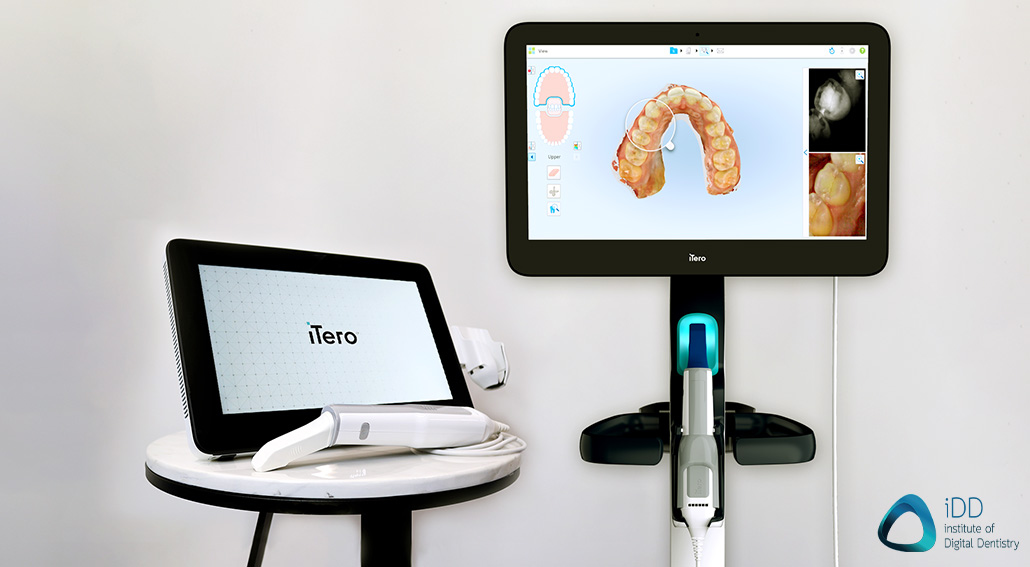iTero Element 5D Plus Series
The iTero Element 5D Plus series was released in February 2021 as the latest generation intraoral scanner by Align, the parent company of the iTero intraoral scanners. This new intraoral scanner was a relatively surprising release as iTero recently launched the iTero Element 5D just before in early 2019 - first being showcased at the International Dental Show.
Last year, we reviewed the iTero Element 5D. Overall, although it was a good scanner with some fantastic technology built into it, the hardware let it down significantly, resulting in a laggy user experience. To read our review of the iTero Element 5D click here. This year, the team at iDD were lucky to be the first in the Asia-Pacific region, and one of the first in the world to test the iTero Element 5D Plus.
It seems that iTero has listened to our reviews. The new Element 5D Plus is not exactly a brand new scanner as it is the same as the previous generation Element 5D. Instead, the changes are entirely hardware-related. There have been significant improvements to the computer components that run the scanner, resulting in a vastly better user experience. It also looks a lot better. The Plus Series comes in two options - a new cart and a tablet (mobile) version.
The cart is similar to the previous generation Element 5D cart but with a new modern aesthetic. The mobile configuration is a medical-grade, compact portable scanner solution that delivers the same high-quality images as the cart configuration. You can no longer buy the Element 5D Plus as a USB scanner to use with any computer/laptop, unlike the Element 5D which had this option. It is either a cart or tablet with the Plus series, with the specific computer hardware that iTero has chosen. Those looking for a USB 'plug and play' scanner may opt for the iTero Element 5D laptop configuration or the iTero Element Flex, which is iTero's more 'entry-level' option.
The Element 5D Plus Series is iTero's fifth-generation intraoral scanner. This new lineup of scanners and imaging systems builds on the success of the Element 5D. It offers all of the existing orthodontic and restorative digital capabilities users have come to rely on, with one fundamental improvement - faster processing times for a seamless scanning experience in a new sleek, ergonomically designed package.
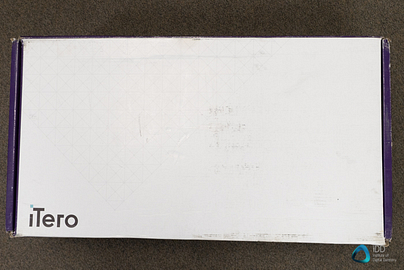
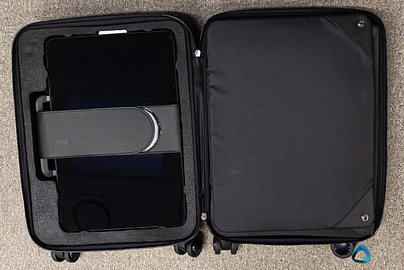
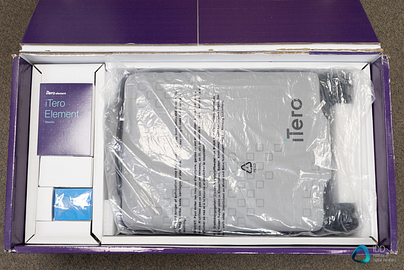
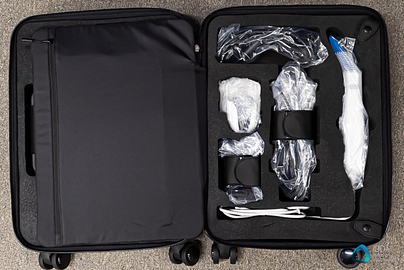
Unboxing the iTero Element 5D PLUS. The mobile version comes in a handy travel case.
Disclaimer - no conflict of interest. This is an objective review of the iTero Element 5D Plus and we do not have any ties to Align Technology or iTero. The team at iDD remains unwaveringly committed to providing you with impartial and trustworthy information and therefore we do not seek any sponsorship. Align Technology had no part in writing this review or restricting any conclusions iDD makes in our thorough analysis and clinical use of these products. With that said, below are our findings and in-depth discussion about the iTero Element 5D Plus and how it compares to the other intraoral scanners on the market. Enjoy the review.
Review Overview
Evaluation Ratings
Scanning Speed
Scanning Flow
Scanner Size
Ease of Use
Investment Cost
Additional Features
Touch Screen
Both Cart and Mobile Version
Wireless Scanner
Caries Detection
Near-Infrared Imaging (NIRI)
CAD Integration
Scanner is scan-only but can be seamlessly integrated with exocad
Subscription Requirements
Yearly-fees are essentially mandatory for its optimal use
Autoclavable Tips
Single Use Non-AC Tips Only
Don't have time to read the full article?
Scanning Speed
The iTero Element 5D Plus has seen a significant improvement in scanning speed. The prior generation Element 5D scanner was average and not close to being the fastest scanner on the market. The new iTero Element 5D Plus has completely changed this and is easily one of the fastest scanners available. It is incredible what updated hardware can achieve, as using the iTero Element 5D Plus felt like a completely different product to the Element 5D. Each full arch scan could be efficiently completed in around 30 seconds with the Plus Series. All the issues we had previously with iTero scanners that revolved around lagging software are resolved, resulting in a surprisingly pleasant scanning experience. The Element 5D Plus produces high-definition color images, that are life-like. These scans look great.
When using iTero scanners, they are positioned uniquely in that the scanner tip is held as close as possible to the tooth surfaces. The large size of the iTero Element 5D Plus remains a pain point as it is still challenging to scan some tight to reach areas like distal surfaces of terminal molars. Overall, the new hardware in the iTero Element 5D Plus has resulted in a significant improvement in scan speeds. This latest iTero scanner is now comparable in scan speeds with other scanners such as CEREC and TRIOS. This is a fast intraoral scanner and the fastest iTero have ever made. Check out our video below to see it in action.
Scanner Size & Ergonomic Design
Scanner size and ergonomics are still some of the drawbacks of the scanner. The iTero Element 5D Plus has not changed at all compared to the previous generation, Element 5D. The iTero Element 5D Plus scanner is large, heavy, and quite bulky to use. This scanner weighs close to 500 grams, making it easily one of the heaviest intraoral scanners on the market, double the weight of some other scanners. The only intraoral scanner that comes close to this weight is the CEREC Primescan at around 457 g. The weight of the scanner may not be a concern for some clinicians, but due to this and its sheer size, it is one of the least comfortable scanners to use for an extended period of time.
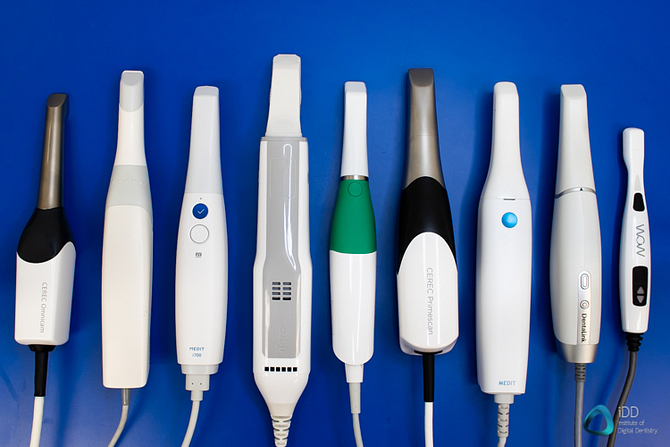
The iTero Element 5D Plus is one of the largest and heaviest scanners on the market
Secondly, the design and shape of the scanner wand has not changed significantly since the first generation iTero Element intraoral scanner. There are some unique design choices that iTero opt for, such as the scanner head not being parallel with the scanner body. Instead, it protrudes downwards at about a 45-degree angle. The shape and size of the scanner head are said to be designed in this way so that while in use, the scanner itself will retract soft tissues meaning that one person can scan without requiring an additional person to provide retraction of the cheeks/tongue. There is no doubt that this design does help somewhat with soft tissue retraction, but at the same time, it also makes scanning tight to reach areas more inconvenient. On top of all this, the iTero Element 5D Plus still has one of the largest scanner heads on the market. A larger scanner head means it is harder to use in small mouths and hard to reach places. It can be tricky to capture the distal surface of a second or third molar using this scanner, for example, and scanning children can be problematic.
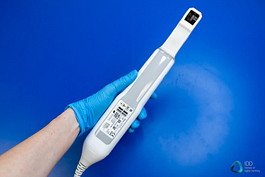
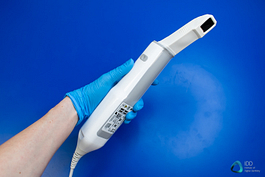
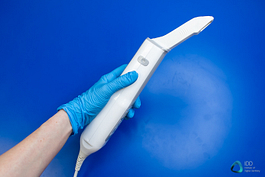
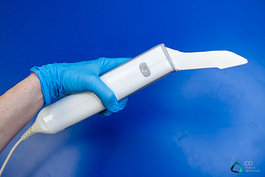
The iTero Element 5D Plus is the same scanner as the Element 5D
In regards to the quality of the scanner, it is very well built. It does not feel like a cheap scanner like many flooding the market now. There is a single button on the scanner you use to start and stop the scanning process, which is conveniently placed on the side of the scanner in easy reach of your thumb when holding it. The ergonomics of the scanner seem to be well thought out. It is the weight and size that lets it down.
As mentioned above, the scanner comes in 2 configurations; wheel-mounted cart or the tablet mobile version. The design of the cart looks great. It is sleek, modern, and futuristic looking. It can be easily transported between surgeries, and the touch screen works with no issue. For those looking for an even more portable scanner, the iTero Element 5D Plus Mobile version exists. For our review, we used the mobile version, which is basically a tablet and worked very well. It is impressive how such a small device can power the demanding software. The mobile version is the perfect size for a tablet. Large enough to engage the patient to see what is happening on-screen, yet small enough to enable easy transportation. It does everything you need it to do very well, starting with a responsive and easy-to-use touchscreen.
While using the iTero Element 5D Plus Mobile, we found that the size was great for placing on the clinic bench without feeling like it was in the way. The Mobile version also comes with an integrated VESA interface in the back, so you can easily mount it to your dental chair or any other type of standard mounting and enjoy a zero-footprint scanner. Furthermore, the iTero Element 5D Plus mobile version is one of the most convenient and well-designed portable scanners on the market. It is better than USB 'plug and play' laptop configuration scanners in terms of portability.
Laptop configuration scanners that are flooding the market, in general, have many challenges. Though it might be easy to pack and take from clinic to clinic, it is quite a nuisance to move within the clinic from room to room, or chair to chair, due to the many cables and components. All of that is solved with the iTero Mobile configuration.
The other benefit of the iTero Element 5D Plus is that it a medical-grade device. This means you can use common cleaning and disinfection materials on it with no issue. Compare that to laptops which that are not, and often require all kinds of plastic covers. These are not even used in many practices which raises an interesting discussion about cross-infection control and laptop scanners.
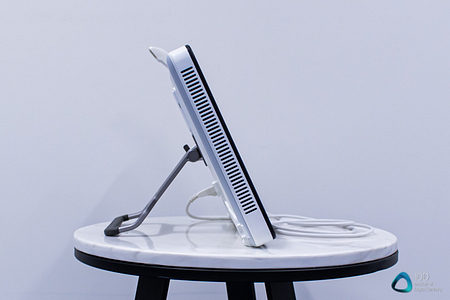
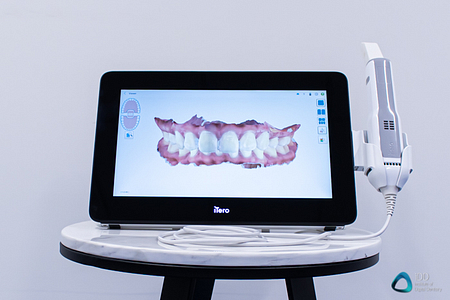
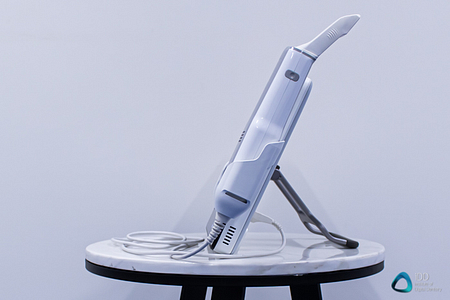
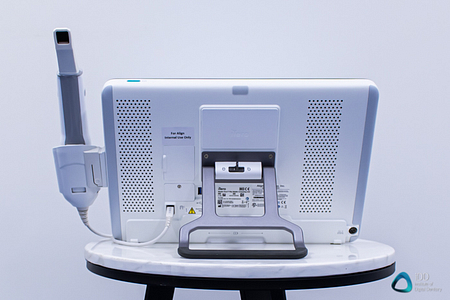
The iTero Element 5D Plus Mobile tablet works well and looks great
Now that iTero has sorted out their hardware issues that plagued prior generation scanners, they have created a fantastic scanning experience. We particularly liked the Mobile version of the iTero Element 5D Plus. We hope the next step is to radically change the size and weight of their next-generation scanner wand.
Internal Fan
Like its predecessor, the iTero Element 5D Plus has an internal fan in the scanner. Inbuilt fans or heaters are the market norm, and you will find this feature on almost every intraoral scanner on the market. In most scanners, an internal fan or heater keeps the scanner window and mirror warm, preventing fogging up in the mouth.
In the iTero scanners, the internal fan is not used for defogging. Instead, the fan is used to keep the scanner temperature controlled and prevent overheating. iTero uses a patented technology for defogging. The window at the tip of the scanner is conductive, so electricity is used to quickly warm it to the desired temperature and keep it there. This also helps maintain perfect optical properties.
This technology makes it easier to scan for extended periods in the mouth without the scanner fogging up at all. In our experience, it worked very well when using the iTero Element 5D, and we had no issues with the scanner tip fogging up. It also works fast, with the scanner being able to be used soon after start-up. One thing that did stand out is the sound of this fan and air passing through the scanner is relatively loud when in use, not quite to the point where it was annoying but audible and louder than other scanners.
Don't have time to read the full article?
Full Arch Scanning
The iTero Element 5D Plus does very well in full-arch scanning, much better than its predecessor the Element 5D. When we used the scanner, we could easily take full arch scans in under 45 seconds. The effectiveness of this scanner at full-arch digital impressions is much better than any previous iTero scanner, and even better than most scanners on the market. Its success lies in its new hardware, which powers the demanding software and the brilliant AI that cleans up scans seamlessly.
The iTero Element 5D has the trifecta of fast scanning - speed, smooth scanning experience, and a smart AI. The intelligent AI helps tremendously as it consistently removes soft tissue artifacts, live while scanning is taking place. It is impressive how accurate it is at differentiating between the tongue/cheek and the tooth structures. The inbuilt fan helps with scanning for long periods without compromising continuity. The digital impressions that are produced also look great.
Scanning edentulous spaces and full arches is another story. As always, this is much harder to do than dentate arches with intraoral scanners. The iTero Element 5D Plus does an acceptable job at this. Not the easiest and it is important to turn off the AI function that will constantly try to remove soft tissue artefacts.
Research on the accuracy of the iTero Element 5D Plus has not been released yet. Although we do not yet know how it compares to all other scanners, we can safely assume it performs just as well as the Element 5D, which was proven to be one of the most accurate scanners on the market. Click here to read an in-vitro study that compared many intraoral scanners on the market and found the Element 5D to be one of the most accurate.
We have used the iTero Element 5D Plus in combination with exocad to fabricate restorations in-house. We did not have any issues with the fit of any prosthetic. This scanner works well. Clinicians must realize that research has clearly shown that scanning accuracy is greatly affected by the operator and scanning protocol used. You can have the most accurate scanner in the world, but a poor scanning technique will significantly impact accuracy.
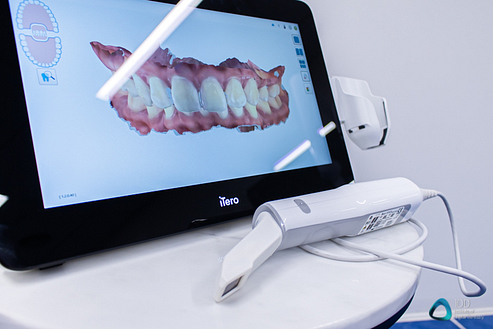
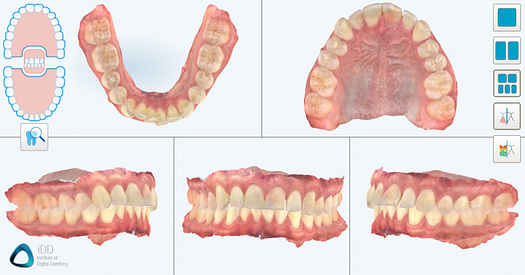
Full arch scans using the iTero Element 5D Plus Mobile. High definition and realistic colors.
Invisalign Outcome Simulator
The Invisalign Outcome Simulator is a very popular function of the iTero Scanners. It has become one of the standout features of iTero when compared to others on the market, and it is one of the best features of the iTero Element 5D Plus. In brief, the outcome simulator creates an orthodontic alignment simulation after you have taken full arch scans. The software is much faster than before thanks to the new hardware, taking about 1-2 minutes to fabricate this simulation. This includes automatic segmentation of all the teeth, which is done perfectly every time we tried it. The orthodontic simulation that is produced on the scanner itself is entirely interactive and can be modified as required. These Invisalign simulations are a powerful motivation tool for any patient interested in orthodontics / Invisalign.
This Outcome Simulator built in the iTero Element 5D Plus is quick to use, easy to follow, and effectively shows how teeth could move with orthodontic/ Invisalign treatment. Strong emphasis on could, as this is not a treatment simulator like a ClinCheck from Invisalign. The Outcome Simulator is just a quick example, and sometimes the results are not entirely achievable or aesthetic. It is purely just a motivation tool, yet an incredibly good one at that.
The iTero Invisalign Outcome Simulator is still one of the, if not the best orthodontic simulators on the market. Although orthodontic simulation has been copied by other companies such as 3Shape and Medit in their own scanner software, the iTero version feels a lot more extensive and has superior aesthetics. This feature alone will be enough for many orthodontic-centered practices to invest in iTero.


Outcome simulator is a extremely powerful orthodontic patient motivational tool.
Caries Detection - Near Infrared Imaging (NIRI) Technology
The iTero Element 5D Plus uses near-infrared imaging (NIRI) technology for caries detection, exactly the same as the Element 5D. This tech enables you to scan the internal structure of a tooth in real-time and functions as a diagnostic aid for the detection of interproximal carious lesions above the gingiva. You can also monitor the progress of such lesions without the need for radiography. It is an excellent and innovative piece of technology that works well. iTero is the first to use NIRI technology in an intraoral scanner, and it is arguably the best caries detection tool in any scanner available on the market. The iTero Element 5D Plus is also the only scanner (besides the Element 5D) that simultaneously records 3D scans, intraoral 2D color images, and NIRI images in one scan. The only other scanners with caries detection functions are the TRIOS4 and Planmeca Emerald S, but these require additional scans to be taken.
The iTero Element 5D Plus enables the comparison of these images over time using the iTero TimeLapse function, which is a neat feature and great for patient education and communication. Although not unique to iTero, the TimeLapse feature enables comparing different scans that have been taken at different times. This allows you to predict issues and diagnose problems by comparing any changes in these scans over time. An example of this feature would be reviewing soft tissue recession, abrasion, erosion, and tooth movement. The comprehensive imaging system seen in the iTero Element 5D Plus gives clinicians an excellent reason to incorporate the iTero in every patient examination, at every visit. Rather than just an impression tool, this changes the whole dynamic of an intraoral scanner as it can also help with diagnostics. NIRI technology may be heralding a new era of patient management and education.
The one thing to note is that the NIRI images require training and a good understanding of what you are examining with this technology. It can sometimes be tricky to tell what it is showing and whether it is just normal anatomy. Like with any diagnostic tool, you obviously wouldn't rely on this to make clinical judgments, and it is designed to compliment all other diagnostic tools you may use. Overall, a great feature that is nice to see in an intraoral scanner. It has many uses, for example, screening a pregnant patient or those who refuse radiography for whatever reason.
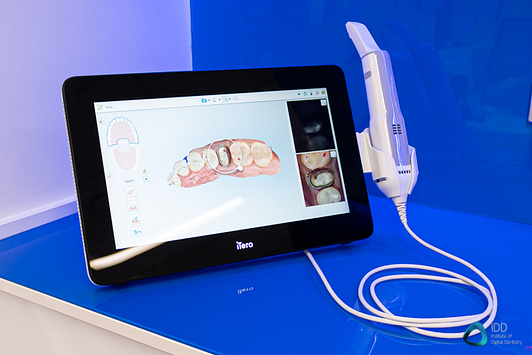
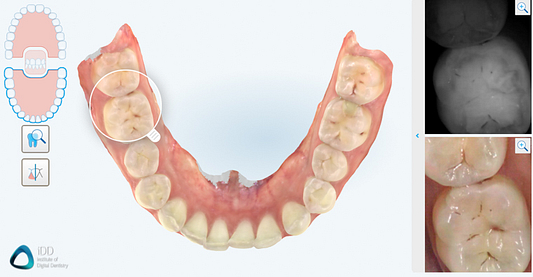
NIRI a useful caries detection aid built into the iTero Element 5D and 5D Plus
Ease of Use
The iTero software is easy to use but has some confusing UI choices that let it down. All intraoral scanners, including the iTero, follow a simple step-by-step progression. The typical workflow is as follows: filling out the lab sheet and patient details, scanning the preparation, scanning the opposing teeth, and finally, scanning the bite.
The iTero line of scanners uses unique terminology not used in any other intraoral scanner. This can make it confusing for users coming from another brand of scanner. For example, when setting up the lab sheet before scanning, you are given the following 'case selection' options:
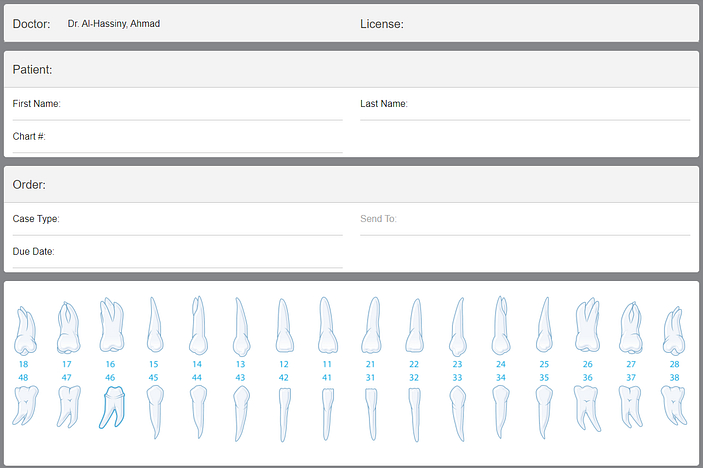
Although the meaning of some of these is intuitive, others are not, and frankly, it is confusing and convoluted. Simply choosing a case type requires understanding the specific terminology iTero uses, and some options feel unnecessary. For example, iRecord is a simple digital impression, or in other words, a full arch scan. iCast is the same but with a American Board of Orthodontics (ABO) base added. Having these as different case types is confusing, and this could be a 'toggle base' on and off switch.
What is even more perplexing is that choosing iCast does not automatically add a base to the scans, as you see in most scanners with an 'add base' option. Instead, the scan is sent to Align, and you are forced to wait for a day or two for them to add the base. In this time you cannot export the scans unless you change case type. This feels ancient and we wonder why something like this is not simply done within the software by the user. Again, other scanners such as Carestream and Medit, enable adding bases for printing scans within 1-2 clicks. Granted, they are not ABO bases but do all users need this?
There are multiple other quirks of the UI especially for restorative purposes. The entire case list is reminiscent of the old iTero indications which were heavily focused on orthodontics, and sending each indication to specific parts of the iTero team. The UI could be significantly refined and streamlined.
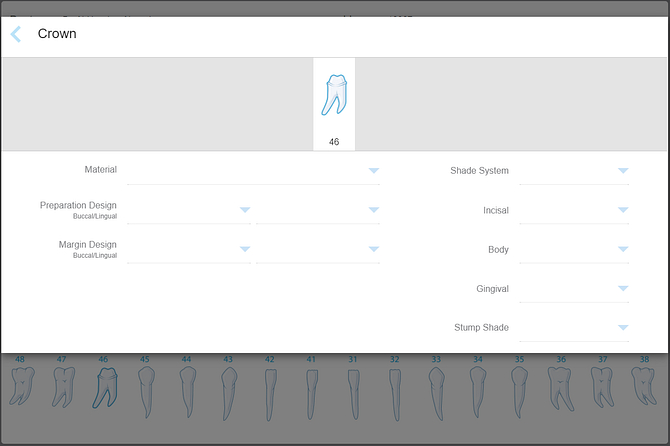
The iTero UI is easy to navigate but has some dated and convoluted options.
Another thing that stands out when using iTero is the relatively limited number of scan analysis/modification tools after taking a scan. Apart from NIRI, all you can do is is check occlusion/clearance, and place margin lines. Compare this to other scanner competitors such as Medit that provide a vast range of different tools available such as assessing scan quality etc.
Additionally, the tools for editing/modifying scans are also limited in the iTero Element 5D Plus. During scanning, when trying to remove parts of a scan, you can only click on areas of the scan, and the software AI removes the area connected to the site you clicked on (similar to the patch tool in TRIOS). This type of tool is not the best way carefully delete specific parts, and often the software AI removes too much. For instance, if you are trying to remove a small area of a prep covered by gingiva to rescan. It would be much better to have other options like a 'paint brush' or 'lasso' tool found in other scanners, allowing you to remove specific parts of the scan that you draw over. Although these tools do exist in iTero, it is not until the scans are processed that you can do this. Leading again to some confusing and convoluted UI choices.
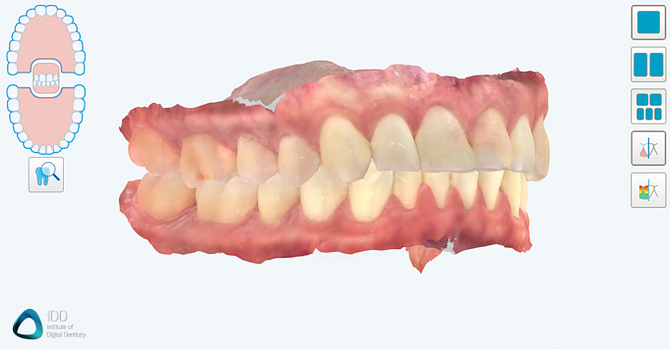
Beautiful scan images produced by the iTero Element 5D Plus. Basic scan analysis tools.
Another interesting workflow decision in the restorative aspect is the need for an extra 'high definition' scan segment. This is mandatory for any restorative indication such as crown and bridge. When carrying out a scan for a single-unit crown, for example, with all other intraoral scanners, you scan both arches and the bite. With the iTero scanners, you are required to take an additional scan of the preparation itself. This HD scan segment is of much higher resolution. The need for this is understandable, a much higher quality image of what matters - the preparation margins and contacts. But why this is mandatory in iTero and not all other scanners is annoying. Other scanners also have an 'HD' scan option, but this can be toggled on or off based on the user's requirements.
Having this mandatory HD scan segment is not a big deal for single units, and you get used to it. What is problematic, however, is that it introduces some poor workflow problems for bigger cases. For example, if you plan to do multiple tooth preps, lets say ten teeth for a cosmetic case, and you input ten separate crowns in the lab sheet, you are required by the software to carry out ten separate HD scan segments. This is incredibly time-consuming and feels like poor UI design. Users get around this by scanning all the preps in one HD segment, but it should not be up to the users to find workarounds. The workflow for restorative purposes needs rethinking.
Moving on, the iTero Element 5D Plus does not have any CAD/CAM software. It is just a scanner. For those looking to carry out the entire CAD/CAM workflow in-house, you will need to invest in CAD software and a milling machine. With Align's recent acquisition of exocad, there is a big move for the combination of iTero with exocad. Although the exocad software cannot (yet?) be used on the iTero Element 5D Plus itself, it integrates with the scanner seamlessly. Any scans can be automatically sent to your separate computer with exocad installed.
Overall, the software UI works well enough. On the one hand, it has impressive orthodontic simulation software and quite advanced caries detection for an intraoral scanner. Yet, on the other hand, it lacks some fundamental scan analysis and modification tools and has some convoluted UI choices. The workflow for restorative purposes needs some improvement.
Don't have time to read the full article?
Exocad
Exocad (stylized as exocad) is one of the leading dental software companies globally. The company focuses solely on developing CAD/CAM software that is hardware neutral, completely open, and usable with CAD/CAM hardware from any manufacturer. Their software has been integrated with systems by Amann Girrbach, ZirkonZahn, KaVo, and others. exocad was a privately held company until its recent acquisition by Align Technology in March 2020, for $419 million. Yes you read that right. Align now own both a prominent intraoral scanner company, iTero, and a dental CAD company, exocad.
exocad software is separated into multiple different modules and bundles for each design indication. These are purchased separately and can get confusing. We have used exocad in our in-house lab for over five years for many indications, from simple crown and bridge, to full arch prosthetics milled in-house. exocad is one of the best CAD software available, hands down. It is robust and comprehensive. The downside of exocad is that it is a lab software, and thus it is much more technical than any chairside software such as CEREC. Simply put, this is software that requires extensive training and is not the easiest to use.
The cost of exocad is as confusing as the software itself for a new user. There are a lot of different modules that can be purchased separately. Without breaking down every single cost, we recommend ensuring you understand what is included with your bundle and what is not. Ask your reseller. Also, be aware that exocad has a one-off purchase fee and a yearly subscription. You can expect to spend anywhere between $8000 to $18000+ for all the modules, plus annual fees between $2000 to $5000+.
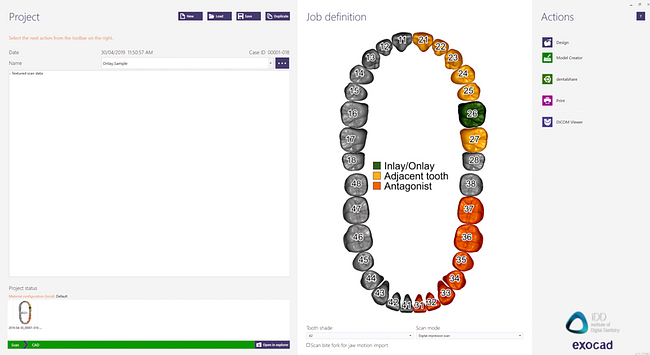
The exocad user interface during the prescription or lab sheet stage.
DentalCAD and Chairside CAD
Traditional exocad aka DentalCAD, has been mainly advertised as a laboratory software for dental technicians. ChairsideCAD was developed for use in the dental clinic as a chairside software. The designing interface itself is identical to DentalCAD, but ChairsideCAD offers fewer indications and modules. This chairside version of exocad is not designed to create prostheses that are traditionally difficult to manufacture, e.g., removable prosthetics. Additionally, nesting restorations into material blocks is simplified within the same software rather than using a separate CAM manager software such as exocam.
In our review period, we tested ChairsideCAD with the Smile Creator module. As a whole, the software works well. We tested DentalCAD's crown and bridge functions, and again, everything works perfectly. Crowns were fitted with no issue, all fabricate in-house using Amann Girrbach milling machines. Anyone familiar with exocad will be right at home with this chairside version. This is a very versatile software and has a vast range of tools that you can use to master your designs.
One thing to note is that even chairside exocad is not nearly as user-friendly as other chairside software, such as CEREC. ChairsideCAD still feels like a lab software and will likely overwhelm new users. It takes a lot more training to use exocad properly than CEREC or TRIOS, for example. It just simply isn't as fool-proof or easy to use. ChairsideCAD attempts to make it easier when compared to DentalCAD, but merely stripping some of the more complicated functions from the traditional lab exocad is not quite enough for a new user. The UI can seem intimidating at first, but with some training, you can get to grips with exocad.
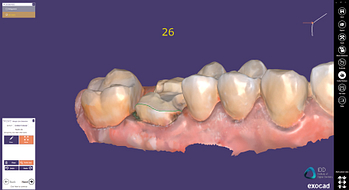
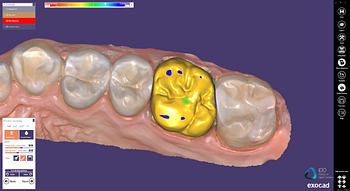
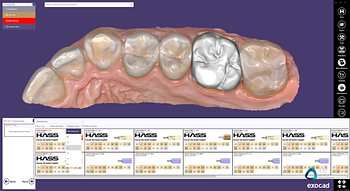
exocad is extremely powerful but it is also much more technical than other chairside software.
Exocad Smile Creator
Smile Creator is exocad's answer to digital smile design. This smile design software focuses on 3D designs rather than a simple 2D overlay on a photograph like most of the smile design apps that are flooding the market.
When using DentalCAD or ChairsideCAD with the Smile Creator module installed, starting any anterior case will cause a software prompt to start Smile Creator at the beginning of the design workflow. You can choose to skip this. If you decide to continue with Smile Creator, the software prompts you to upload the patient's pictures. As with all digital smile design programs you will need a patient's smiling and retracted pictures that are then superimposed over each other in the software.
The Smile Creator module takes this the to the next level and makes you align these 2D pictures with a 3D intraoral scan. This can be tricky and might take some time to get it right, especially since the focal point of the photographs might distort the proportions of the teeth, causing a mismatch between photographs and the intraoral scans. Once this step is complete, you can design the patient's smile and throughout the workflow you will be able to view these pictures and the intraoral scans all aligned together. This enables a true 3D smile design to be fabricated and then subsequently printed.
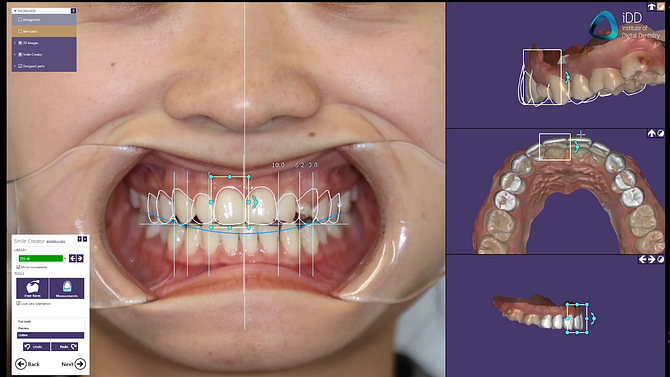
exocad smile creator software enables 3D digital smile design.
Unfortunately, there are some drawbacks to this software. First, the teeth textures used for the smile design are lackluster. The design may be perfect, but it still doesn't look very aesthetic, taking away the entire point of presenting this to a patient. Secondly, this module doesn't really work as a motivational tool to use in the clinic. Most notably, it simply isn't easy or quick to use. It can take up to 30-60 minutes for a design to be made and demands a good understanding of creating digital wax-ups and using the exocad software. This is not for beginners. In addition, the software doesn't give you the option to cover the original teeth in the smile simulation pictures, this means you can see them poking out of the sides of the smile design.
The overlap of intraoral scans with extraoral photographs helped tremendously with the smile design. Although, we could think of multiple ways this module and the entire workflow could be improved. In our clinic, we used the Smile Creator module for the creation of digital wax-ups which we later printed and transferred into the patient's mouth using a PVS stent and self-curing composite. Check the video below for the full workflow.
Open or Closed Architecture
The iTero Element 5D Plus system is entirely open and enables easy exporting of the scans. Interestingly you cannot export scans directly from the scanner cart/tablet itself. Instead, the user must log into the "myitero" website and access scans in this way. The benefit of this system is that all scans are stored online automatically and are accessible from anywhere with an internet connection. The downside is that it adds an additional step when trying to export scans you have just taken.
The iTero Element 5D Plus allows exporting scans in multiple file formats, including monochrome STL and color PLY. There is no OBJ export option. Although the Element 5D is a color scanner, if you export in STL and opening in CAD software, you will be designing on a monochrome model, so PLY is an excellent option.
Sending scans for Invisalign treatment: The iTero Element 5D and 5D Plus are the only latest generation scanners that can be used for sending scans to Invisalign. The entire Element range (Original iTero Element, Element 2, Flex) can also be used to send to Invisalign. Scans from all other latest-generation competitors (Primescan, TRIOS4, Medit i500/i700, etc.), cannot be used for Invisalign treatment.
If you still own an older generation CEREC Omnicam and TRIOS3, these can be still be used for now (in some regions, TRIOS3 scans are also blocked, notably the USA). Invisalign is becoming more 'closed' in what seems to be a way to promote the iTero range of scanners.
Don't have time to read the full article?
My Itero
What was once called Myaligntech.com is now called Myitero.com and serves as the cloud-based platform for all your scans and cases. This part of the workflow functions very well and looks the same as the scanner user interface. Myitero.com can be accessed from most devices online and enables you to track orders anywhere, at any time. There is also a 3D viewer built into the platform, which is independent of the scanner. You can access all your cases, change prescriptions, start new cases, and export scans. Furthermore, additional features include viewing the patient's orthodontic simulation and creating custom patient reports from any screenshot that can be used to supplement treatment plans.
Exporting scans from Myitero.com will be the primary use for most clinicians using this platform, and it is easy to do and works well. There are a number of great options that you are presented with when exporting scans. Firstly, as mentioned above, you can choose STL or PLY, or both file types in a single export. Secondly, you can choose to have the arches combined in a single file or have individual files for each arch. With this second option (individual files), you can choose to have the individual arches in occlusion or with the teeth upwards (for printing). You can also choose to export open shells, solid models, or American Board of Orthodontics (ABO) models with a hollow or solid base.
Although the myitero.com cloud platform may seem annoying for some who just want to export scans from the scanner itself, there are many benefits of having a cloud storage platform like this. The fact that it works so well and has a lot of added functionality is even better.
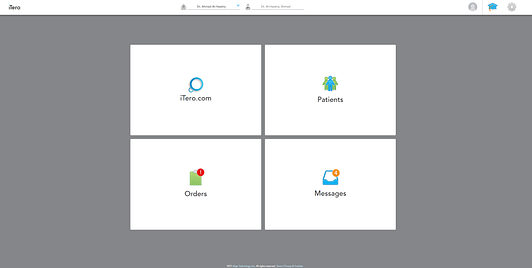
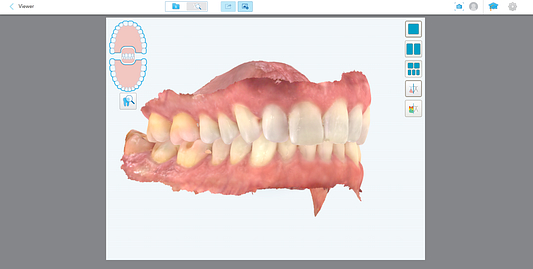
Impressive functionality built into the myitero.com platform.
Cost (NZD)
The iTero Element 5D Plus series comes in four options and price points:
(Lite versions have NIRI deactivated)
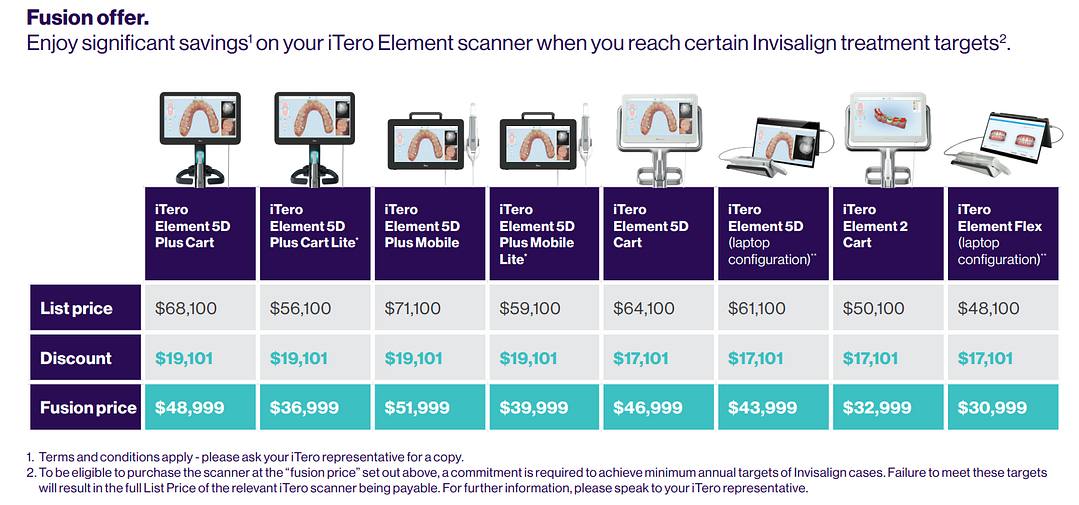
The iTero Element 5D Plus series ranges from $56,000 - $71,600, depending on whether you want the mobile version or not, and if you want the NIRI caries detection function. This price makes the iTero Element 5D Plus one of the most expensive scanners on the market. Note: this price includes a one-year service package.
iTero commonly runs promotions discounting the scanner price by up to $20,000 if you sign up for their "Fusion Agreement" also called a DEP contract.
The Fusion Agreement is structured in that you pay an initial payment followed by single payments at the end of each year, for three years, from the date of scanner delivery. However, the three yearly payments are not charged if a certain number of Invisalign ClinChecks are approved each year.
This Fusion Agreement is a unique concept for a subscription plan but is very Invisalign-focused. Essentially, you are encouraged to sell a certain number of Invisalign cases each year to reduce the cost of your scanner. This agreement can either be excellent for practices who are already major Invisalign providers or want to start focusing on Invisalign treatment, but it makes no sense for those not interested in orthodontics. Also, note that that the number of cases per year required for the Fusion Agreement is based on how many Invisalign cases you already do.
There are also trade-in and multi-unit offers, as seen below.
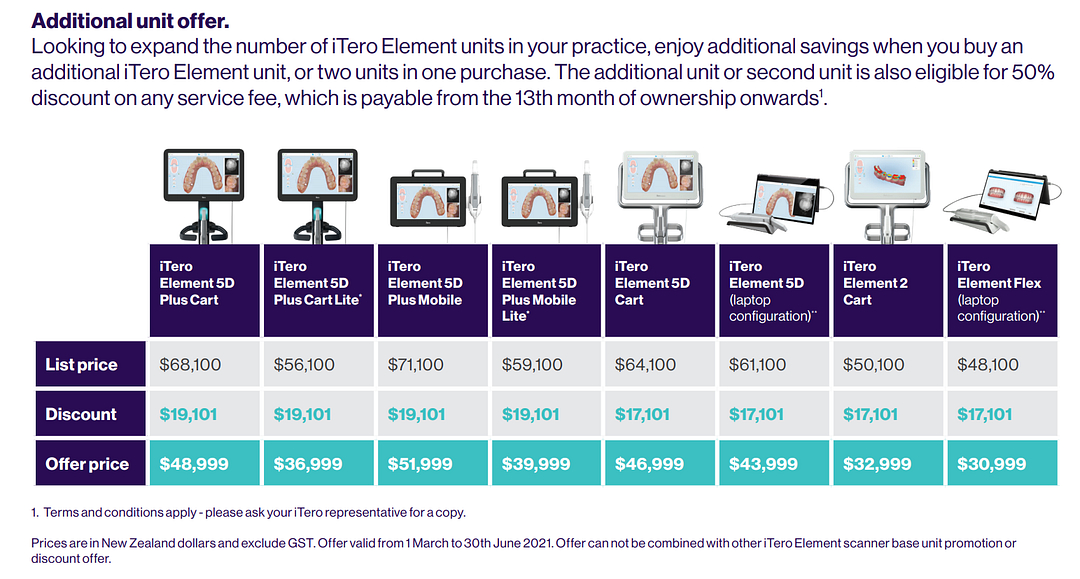
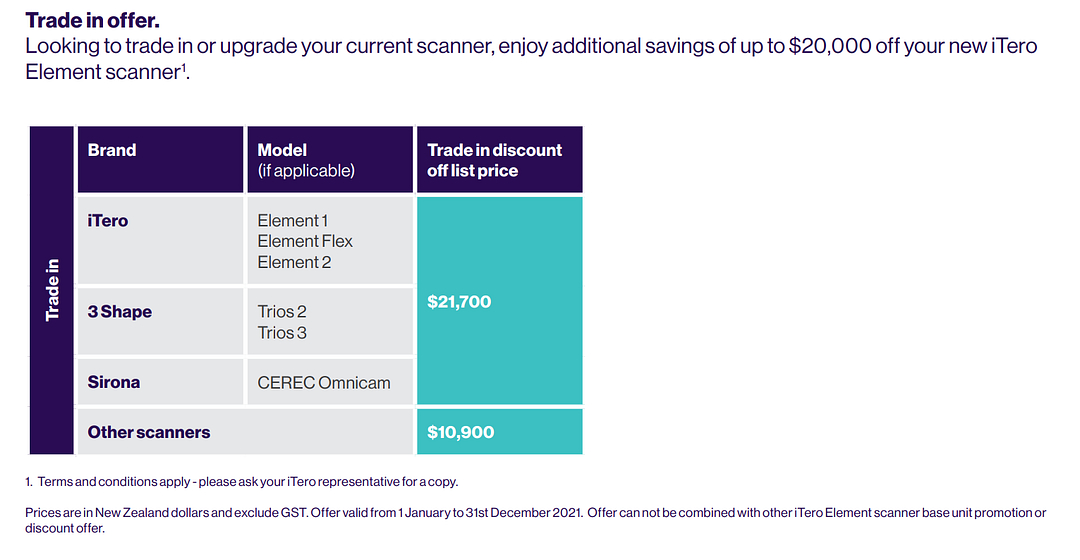
Don't have time to read the full article?
Yearly Fees / Subscription (NZD)
There are two other ongoing costs aside from the cost of the scanner/Fusion Agreement:
1) A yearly subscription fee of approximately $550 per month (excluding GST) or $6,600 per year (first year included in the purchase price). Note: the subscription plan and Fusion Agreement are separate costs.
There is an option to opt out of the subscription fee at any time. If the subscription is cancelled, using the scanner for invisalign scans/digital dental records remains free of charge, but any exported files cost $30 per scan.
Without the yearly subscription the scanner is also no longer covered under warranty, and certain features are removed. An annual warranty can be purchased separately for $3000 without the subscription fee. The invisalign outcome simulator as well as myitero.com access is available regardless of choice of subscription or service package.
Opting to go without the subscription fee may be a good option for clinics with multiple iTero scanners and want to dedicate some of them for Invisalign scans and not exporting STL. If you only have one iTero Element 5D Plus, the subscription is practically mandatory to ensure all features work and to get all the scanner benefits.
2) Scanner sleeves. The iTero Element 5D Plus uses single-use scanning sleeves. These must be discarded after each use and are not autoclavable. Sleeves are bought in boxes of 25 for $100, meaning each sleeve costs $4. In other words $4 per scan which is the highest cost for any scanner sleeve on the market. The environmental impact of all this plastic waste is another concern.
The cost of the scanner, expensive subscription fee, and single-use scanning heads mean that the iTero Element 5D Plus is one of the most expensive scanners on the market with some of the highest ongoing costs.
In saying that, being an iTero user and subscriber does have some benefits. iTero offers full replacement warranties for any faulty hardware, and fast local Tech Support, iTero Trainers, Customer Support as well as unlimited cloud storage. iTero also provides free clinical/technical webinars to support their doctors’ continuous education. The subscription also means that you get free access to all the latest/new software features improvements from R&D.
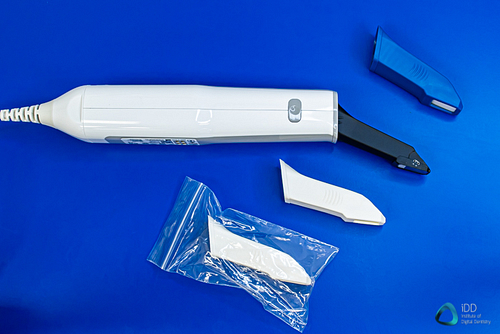
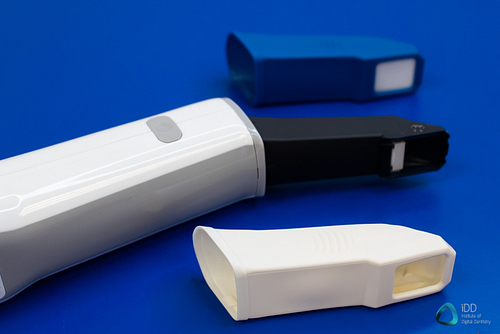
Single-use scanning heads that are used with the iTero scanners.
Review Summary
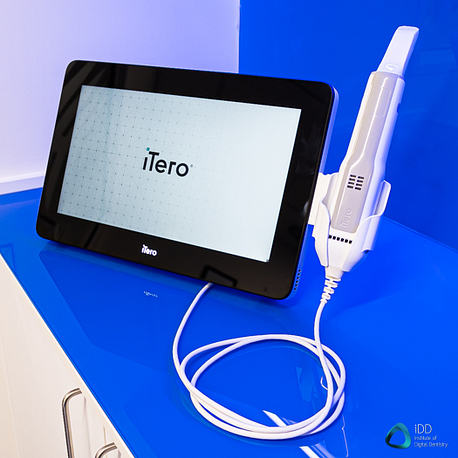
In summary, this is our in-depth look at the iTero Element 5D Plus scanner. In this comparison, we have focused on the clinical aspects rather than technical specifications. Overall, the iTero Element 5D Plus is a great scanner that builds on the unique and innovative features of the Element 5D. The main factor that impressed us is the imaging capabilities, and it is great to see a company constantly innovate and bring entirely new technology to the scanner market.
The iTero Element 5D Plus is the same as the Element 5D but with much better computer hardware, making it a vastly better scanner. It builds on the success of the Outcome Simulator and seems to be a scanner perfect for an Invisalign-focused clinic. The scanner delivers multiple uses, including diagnosis, restorative, Invisalign, and patient education. If you are considering getting an iTero scanner, make no mistake, the Plus Series is the one to get.
In saying that, we still have issues with the size and weight of the scanner. It remains one of the largest and heaviest scanners on the market. Furthermore, there are some very convoluted user interface and workflow aspects, especially for restorative purposes. The software needs major improvements to the restorative elements and to move away from the clearly significant orthodontic influence.
The iTero Element 5D Plus also is not cheap. At $56,000 - $70,000, it is one of the most expensive stand-alone scanner options, with one of the most costly subscription models. It is priced at the premium end of the market. Whether that is justifiable will depend entirely on the specific requirements of the clinic.
We can see the merits of the iTero Element 5D Plus, especially now that it is a very fast scanner to use. For those looking to carry out CAD/CAM in-house, this scanner can be integrated with exocad seamlessly, and there is a significant push from Align to make this workflow better and better for chairside dentistry. Especially, in the light of their acquisition of exocad.
For those who have based their practice around Invisalign, this is the scanner to buy. It is modern, fast, and completely compliments the Invisalign system. It can also be used for diagnostic and restorative purposes. For those with no orthodontic or invisalign interests, this is technologically innovative and impressive, but comes with a high price tag. iTero still has a bit of work to do in order to be competitive in restorative dentistry, especially for chairside CAD/CAM.
Thanks for reading this review. If have a question, please leave a comment below.

